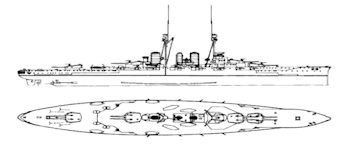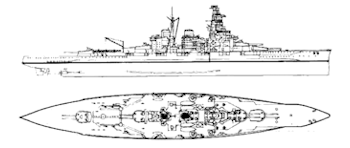




The Kongo-class, originally built as battlecruisers, were among the most powerful capital ships built in the pre-World War I period and were also the last Japanese capital ships that were commissioned abroad (by the British naval architect George Thurston). As battlecruisers, the Kongo-class ships were optimized for armament and speed. Initially designed with 12-in (300-mm) guns, these were upgraded during construction to 14-in (360-mm) guns in four twin turrets; these were among the biggest caliber guns in a warship at the time. Secondary armament consisted of sixteen 6-in guns installed in casemates along the hull and upper deck. Further anti-aircraft armament was also added, and this was modernized later in the ships' life although the lighter guns suffered from poor performance. Armor protection was originally relatively light but this was substantially upgraded over the ships' service life which resulted in their redesignation as battleships in the 1920s. Their initial maximum speed of over 27 knots fell slightly after their conversion into battleships, but was increased following the installation of new oil-fired Kemplon boilers in the mid-1930s. With a new maximum speed of 30 knots they became the fastest battleships in Japanese service. Characteristic pagoda-style towers were also installed during this final reconstruction. The four ships of the class were involved in patrols during World War I and some were used as troop transports during the Sino-Japanese War. All four were quite active during World War II, although the Hiei and Kirishima were sunk off Guadalcanal, the latter in one of the few battleship versus battleship duels in the Pacific.
Kongo was the last Japanese capital ship built abroad (in the UK), and construction of her three sisters took place in Japanese yards. Along with the Haruna it was active in the invasions of Malaya and Singapore, and also participated in the campaigns in the Dutch East Indies and Ceylon. It was also present at Midway, along with Hiei. It was active in most subsequent naval operations including Guadalcanal, the Philippines Sea, and Leyte Gulf but was sunk by a US submarine in late 1944. Hiei was demilitarized as part of the Washington Treaty but later reactivated, participating in Pearl Harbor with the Kirishima. The two ships would serve in most campaigns after that but both were sunk in the Naval Battle of Guadalcanal; the former in an engagement with cruisers and destroyers, and the latter by the USS Washington but not after severely damaging the USS South Dakota. The Haruna was active in most battles and survived the war until July 1945 when it was sunk at Kure by US naval aircraft.
Preceded by:
NoneSucceeded by:
Fuso (1915)| Ship | Code | Builder | Laid | Launch | Comm | Decomm | Fate | ||
 |
Kongo † | Vickers | 17/01/1911 | 18/05/1912 | 16/08/1913 | 21/11/1944 | † | Loss by submarine | |
 |
Hiei † | Yokosuka K K | 04/11/1911 | 21/11/1912 | 04/08/1914 | 13/11/1942 | † | ||
 |
Haruna † | Kawasaki | 16/03/1912 | 14/12/1913 | 19/04/1915 | 28/07/1945 | † | Loss by aircraft | |
 |
Kirishima † | Mitsubishi | 17/03/1912 | 01/12/1913 | 19/04/1915 | 15/11/1942 | † | Loss by surface ship |